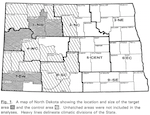Wheat Yield Study
Though evaluations that attempt to statistically establish and/or quantify precipitation or hailfall are useful, the "bottom line" for the county-sponsored NDCMP is really what is obtained in terms of increased crop yields. When all is said and done, it doesn't really matter how the crop production is increased, or how the objective of less hail is achieved, it is only important that benefits are realized, and that they in fact are due to the cloud seeding program-- not chance. In an attempt to define this "bottom line", wheat yield data for western North Dakota were analyzed for the growing seasons from 1935 through 1988 (Smith et al. 1992). Figure 1 best illustrates the findings of this study. The historical target-control relationship, prior to any seeding, encompasses the years 1935 - 1966, the years 1967 - 1975 (the mid years) represent years where some seeding was done in the target areas, and the years 1976 - 1988 represent the NDCMP years where seeding was conducted over all of the target area. The difference? While the historical period revealed no significant differences in yields, about 2.8% more wheat was harvested in the target areas during the mid years, while yields increased by 5.9% during the NDCMP years relative to the historical relationship. That's an additional 2 bushels per acre on a 35 bushel per acre crop.
Note that during drought years 1980, and 1988, little difference in yields is observed between the target and control areas. This comes about because droughts in North Dakota are generally characterized by a shortage of clouds having sufficient lifetimes and/or liquid water contents to produce much rain; factors which also significantly limit seedability. While the ultimate conclusion is that present cloud seeding technology cannot break a drought, the larger implication for the wheat yield study by Smith et al. is that one would not expect to observe a significant difference in yields during dry years. That implication is borne out by the data, lending additional credence to the conclusion that the 5.9% increase otherwise observed is attributable to cloud seeding. Thus, the bottom line seems to be more production in the target area, without any decrease being observed in the control areas. This is important, for it supports the observations that suggest that rainfall is not simply being redistributed. It appears that more rain is falling over a significant fraction of the state.

